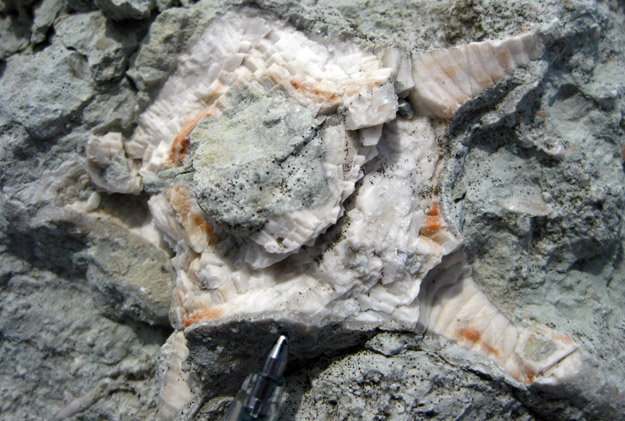Editor’s note: Senior Independent Study (I.S.) is a year-long program at The College of Wooster in which each student completes a research project and thesis with a faculty mentor. We particularly enjoy I.S. in the Geology Department because there are so many cool things to do for both the faculty advisor and the student. We are now posting abstracts of each study as they become available. The following was written by Palmer Shonk, a senior geology major from Dublin, New Hampshire. Here is a link to his final PowerPoint presentation on this project.
I traveled to Estonia in July of 2009 with my advisor, Dr. Mark Wilson, Dr. Bill Ausich of The Ohio State University, and fellow Wooster geology major Robert McConnell. Upon arrival, we were greeted by Dr. Olev Vinn, his wife Ingrid, and their baby daughter. Olev is a geology professor at Tartu University in Estonia. The seven of us then headed for the island of Saaremaa, where I carried out my research. We stayed in the town of Kuressaare, on the southern shore of the island. My field site, the Äigu Beds, is about a 20 minute drive southwest of Kuressaare, on the western shore of the Sõrve Peninsula.
The Äigu Beds (Figure 1) are part of the Kaugatuma formation, named after the nearby town of Kaugatuma. My goal is to use the fossils and lithology at the beds to reconstruct an environment 418 million years old. My group assisted me in collecting fossils from three distinct layers. The first layer, about 8 cm thick, is an argillaceous limestone and contains many fossils still in life position, particularly crinoid holdfasts (Figure 2). This layer represents a calm, shallow-marine environment with soft, submarine dunes. The second layer, about 17 cm thick, shows evidence of a high energy event such as a storm. Fossils in the second layer have been crushed and are cemented together. The third layer, about 30 cm thick, is comprised again of the argillaceous limestone of layer one, but also shows evidence of a small scale high-energy event due to its “mashed” fossil specimens.





Wow! The picture of the crinoid holdfast is amazing! How common are crinoid holdfasts?
Dr. Pollock,
The holdfast you are seeing is only one of many at my field site. There were dozens of holdfasts still in place, in living position. According to Dr. Wilson and Dr. Ausich, something like that is very rare.
Love the pics of the rocks. Query: what would it be like for a time traveler, who landed on that spot, however many million years ago? Is he going to be dodging great awful creatures?
Pingback: Wooster Geologists » Blog Archive » Return to a Silurian crinoid forest
Pingback: Wooster Geologists » Blog Archive » Silurian limestone under our feet